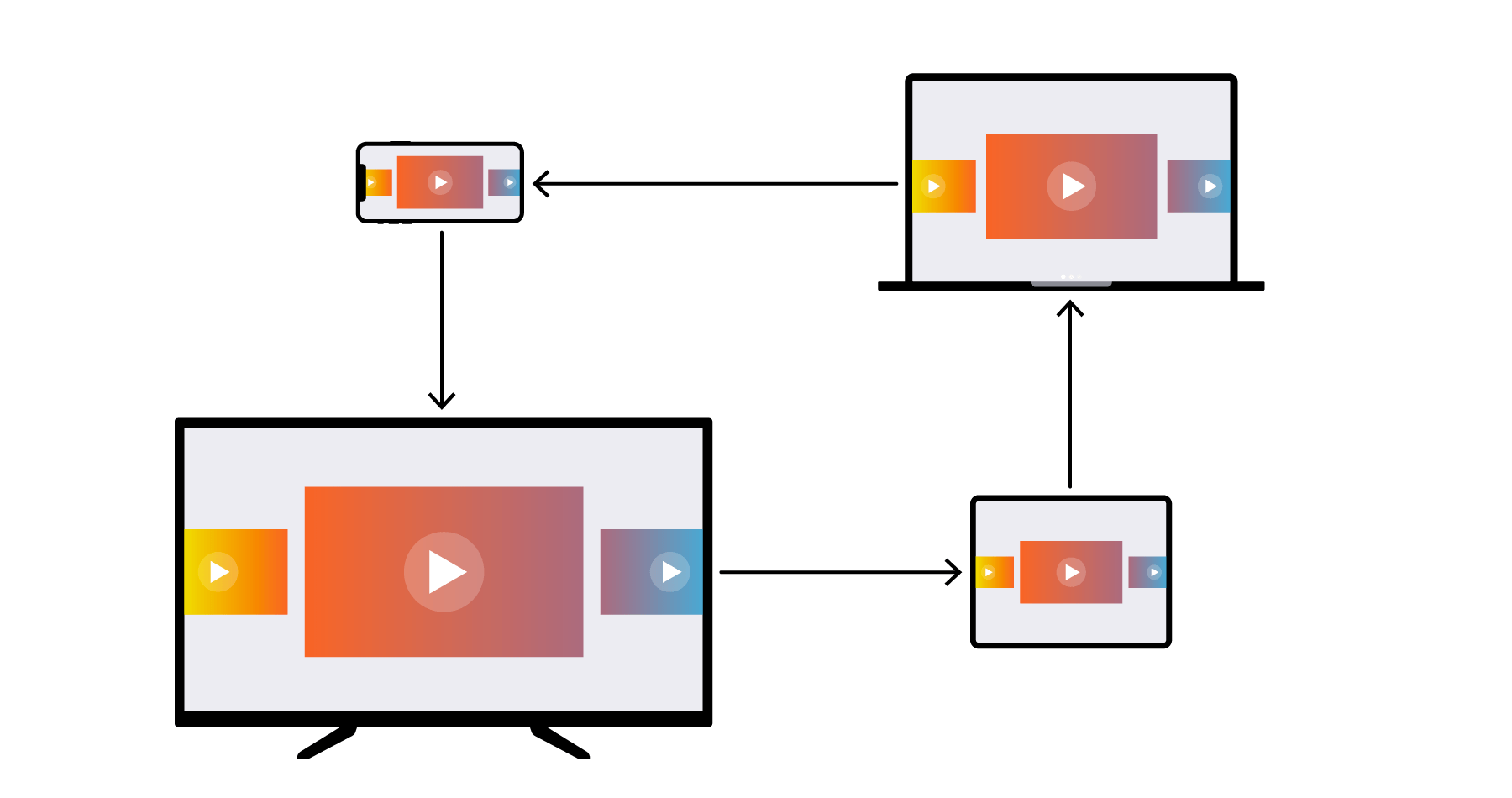With the number of global SVOD subscriptions expected to reach 1.79 billion by 2029, many content owners and licensors are reevaluating their OTT strategies.
Though it’s true that Americans pay for 2.9 streaming services each month, almost half of them have canceled subscriptions in the past year. Just as the pool of OTT viewers is steadily growing, the market is crowded and subscription costs are driving churn.
As a result, many of the largest OTT platforms have released ad-supported tiers while others have launched linear channels. The media landscape continues to change at a rapid pace, with no signs of slowing. To keep up, regularly reevaluate the strategy of your OTT offerings and make sure it’s in line with the latest best practices.
DESIGN YOUR DISTRIBUTION STRATEGY
To launch and grow a successful OTT service, you need to define a compelling content strategy and execute on it to achieve the best results.
Today’s viewers consume content on four main screens: connected TVs or smart TVs, smartphones, tablets, and personal computers. While all types of content can be watched on every device, each screen has a special role in the consumer’s overall video experience. Media owners need to distribute their content across these four screens to drive loyalty and engagement, and they must program each experience efficiently and scalably. When designing your distribution roadmap, you must understand the strengths of each screen.
| Lean-back Viewing | Lean-forward Viewing | Individual Viewing | Group Viewing | |
|---|---|---|---|---|
| CTV | ✓ | ✓ | ✓ | |
| Mobile | ✓ | ✓ | ||
| Tablet | ✓ | ✓ | ||
| Desktop | ✓ | ✓ |
Consider the following factors to define the right distribution strategy for your business.
- Media preferences. Which devices and apps do your target viewers use to stream each type of content they consume? When do they lean back, and when do they view on the go?
- Viewing behavior. How do your target viewers prefer to consume video? Are they binge-watchers? Do they typically stream content at a particular time of day?
- Content strategy. Will you offer live and/or on-demand content? How much content do you plan to offer, and what underlying technology do you need to scale?
- Location. What are the internet and device trends in your region? What languages does your audience use?
Mapping out a comprehensive four-screen distribution strategy will empower you to provide a consistent, premium experience across devices. Not only does it take advantage of the particular strengths of each screen, it makes it easier for viewers to engage with your content.
GOING BEYOND MOBILE
The lean-back experience—where a viewer watches content on a large screen several feet away—is alive and well. In fact, CTV’s share of daily streaming minutes grew from 18% in 2019 to 25% in 2023. Though mobile is still clinging to a majority (51%), smart TVs and set-top boxes (STBs) have proven this viewing experience is far from obsolete.
Furthermore, the global smart TV market reached a value of $195 billion in 2022. This value is expected to grow to $353 billion by 2030—exhibiting a CAGR of around 8% from 2023 to 2030.
CREATE A CONSISTENT EXPERIENCE
To provide the most intuitive user experience for your audience, you must conduct regular testing. During this process, you can determine the best possible experience for viewers by testing different UI elements, such as layouts, branding elements, menu structures, and fonts. By taking a data-driven approach and employing multivariate testing, you can develop a solid understanding of what is and isn’t working and make informed decisions.
Once you’ve conducted your tests, leverage the actionable insights you gained from this data to optimize your offerings on every device. A consistent experience on every screen makes it easier for your viewers to find and engage with your content. Once they master your user interface, they’ll be able to follow the same processes and user paths no matter where they’re watching.
Beyond your UI, video quality is critical to the user experience. Viewers have higher streaming expectations than ever before, and you have to meet them on a daily basis. A simple way to monitor this is with Brightcove’s QoE Insights. You can track issues like error rates and upscaling time to see if any devices have low-quality experiences. Monitoring QoE impairments as they arise allows you to continuously iterate on experience improvements proven to increase audience engagement and long-term value.
CHOOSE YOUR MONETIZATION MODELS
AVOD has been growing at a rapid pace. In North America alone, ad-supported revenues are expected to increase 45% between 2023 and 2029 (compared to 16–17% increases for SVOD and TVOD). Globally, this figure is even higher: 79% growth, from $38 billion to $68 billion.
Certainly, part of AVOD’s success is the ubiquity of FAST channels, but perhaps a bigger part is the emergence of hybrid OTT strategies among top streamers. In 2023, hybrid AVOD/SVOD models brought in $7 billion globally, and this is expected to reach $24 billion by 2029.
You can’t choose the right monetization model for your business anymore; you have to choose the right models. And to do that, there are a few factors that you should keep in mind.
- Content catalog. For larger catalogs with a mix of exclusive and licensed content, the AVOD/SVOD model has become an industry standard. For example, you could offer licensed content on an ad-supported tier and reserve your exclusive content for an ad-free experience. Conversely, smaller licensed catalogs with a focus on live events like sports often do better with TVOD/AVOD. Further, small catalogs with original content may find more success with TVOD/SVOD.
- Audience location. Internet stability varies around the world, as does the use of ad blockers and different kinds of devices. AVOD services may find that SSAI bypasses the risks of viewer disruption and ad blocking, while CSAI’s targeted personalization allows more opportunities for playback issues. Likewise, in regions where content piracy is rampant, SVOD services can be difficult to maintain. At minimum, you’ll need additional measures to authorize viewer entitlements and provide secure playback with DRM.
- Budget. Because SVOD services traditionally offer exclusive content, customer acquisition and retention costs are higher and require bigger marketing budgets. On the other hand, AVOD technology is much more complex and requires bigger operations budgets. Hybrid models offer greater flexibility to mix and match those costs. For example, an SVOD service could heavily market their original content, then transition some budget to an AVOD tier supported by direct advertising. Or, an AVOD service could build their audience exclusively through fully managed programmatic advertising before shifting some budget to licensed live events for TVOD offerings.
Perhaps most importantly, ask yourself if you’ll have enough viewers to justify a subscription service at the onset. It may be better to start off with an AVOD model to attract viewers and incorporate a subscription model over time.
MEASURING AD TOLERANCE
If you implement an ad model, make sure your ad experience provides enough innovative options for advertisers without frustrating viewers. This means aggregating and analyzing data that correlates ad policies with revenue and viewer engagement. Unfortunately for some businesses, doing so can be labor intensive and cost prohibitive, given the already expensive and complex nature of ad tech.
To combat the challenges with reconciling AVOD data, Brightcove’s Ad Insights includes a key metric called ad sensitivity. It compares viewer engagement to elements like ad frequency, duration, and placement and generates a score indicating the likelihood of abandonment. By looking at this metric across content, device, and region, you can easily identify opportunities to increase ad yield without eroding engagement.
REDUCE YOUR CHURN RATE
To grow your audience, you must understand the different types of churn.
- Voluntary churn. This is when users purposely cancel their subscriptions. They do this for a variety of reasons, and there are measurable behaviors that can help you determine which one it is. For example, if engagement is poor, you may need to improve or reassess your content. If they’re abandoning your app without starting any videos, that tells you something about the user experience. And if users go for long periods of time without opening your app at all, push notifications might reel them back in.
- Involuntary churn. This usually occurs when payment fails, but it can also happen when trials expire. The easiest way to reduce it is to partner with a service that automates the process. These partners will notify users when their payment on file is nearing expiration, so they can make an update without a lapse in their subscription.
Overall, it’s crucial that you compare your user acquisition (or conversion rate) with your churn rate on a month-over-month basis. If the churn trend is steady and reasonable, you’re free to focus on acquiring new users. However, if churn is trending up, you need to take the steps described above to continue growing your user base.
CAPTURE YOUR SHARE OF THE OTT MARKET
Viewers’ expectations have increased, as have their appetites for watching content on an ever-growing list of devices. So it’s more important than ever for you to be able to reach your audience—wherever they are. Competing in today’s highly-saturated OTT landscape requires you to get to market quickly. With Brightcove’s OTT solutions, you can launch captivating, consistent experiences for web, mobile, smart TVs, and connected TVs in record time.




